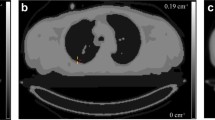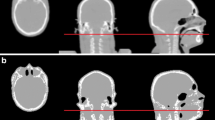Abstract
Purpose
Recent studies have shown an excellent correlation between PET/MR and PET/CT hybrid imaging in detecting lesions. However, a systematic underestimation of PET quantification in PET/MR has been observed. This is attributable to two methodological challenges of MR-based attenuation correction (AC): (1) lack of bone information, and (2) truncation of the MR-based AC maps (μmaps) along the patient arms. The aim of this study was to evaluate the impact of improved AC featuring a bone atlas and truncation correction on PET quantification in whole-body PET/MR.
Methods
The MR-based Dixon method provides four-compartment μmaps (background air, lungs, fat, soft tissue) which served as a reference for PET/MR AC in this study. A model-based bone atlas provided bone tissue as a fifth compartment, while the HUGE method provided truncation correction. The study population comprised 51 patients with oncological diseases, all of whom underwent a whole-body PET/MR examination. Each whole-body PET dataset was reconstructed four times using standard four-compartment μmaps, five-compartment μmaps, four-compartment μmaps + HUGE, and five-compartment μmaps + HUGE. The SUVmax for each lesion was measured to assess the impact of each μmap on PET quantification.
Results
All four μmaps in each patient provided robust results for reconstruction of the AC PET data. Overall, SUVmax was quantified in 99 tumours and lesions. Compared to the reference four-compartment μmap, the mean SUVmax of all 99 lesions increased by 1.4 ± 2.5% when bone was added, by 2.1 ± 3.5% when HUGE was added, and by 4.4 ± 5.7% when bone + HUGE was added. Larger quantification bias of up to 35% was found for single lesions when bone and truncation correction were added to the μmaps, depending on their individual location in the body.
Conclusion
The novel AC method, featuring a bone model and truncation correction, improved PET quantification in whole-body PET/MR imaging. Short reconstruction times, straightforward reconstruction workflow, and robust AC quality justify further routine clinical application of this method.






Similar content being viewed by others
References
Beyer T, Townsend DW, Brun T, et al. A combined PET/CT scanner for clinical oncology. J Nucl Med. 2000;41(8):1369–79.
Delso G, Fürst S, Jakoby B, et al. Performance measurements of the Siemens mMR integrated whole-body PET/MR scanner. J Nucl Med. 2011;52:1914–22.
Carney JP, Townsend DW, Rappoport V, Bendriem B. Method for transforming CT images for attenuation correction in PET/CT imaging. Med Phys. 2006;33:976–83.
Kinahan PE, Townsend DW, Beyer T, et al. Attenuation correction for a combined 3D PET/CT scanner. Med Phys. 1998;25(10):2046–53.
Keereman V, Mollet P, Berker Y, et al. Challenges and current methods for attenuation correction in PET/MR. MAGMA. 2013;26(1):81–98.
Bezrukov I, Schmidt H, Mantlik F, et al. MR-based attenuation correction methods for improved PET quantification in lesions within bone and susceptibility artifact regions. J Nucl Med. 2013;54(10):1768–74.
Martinez-Möller A, Souvatzoglou M, Delso G, et al. Tissue classification as a potential approach for attenuation correction in whole-body PET/MRI: evaluation with PET/CT data. J Nucl Med. 2009;50:520–6.
Schulz V, Torres-Espallardo I, et al. Automatic, three-segment, MR-based attenuation correction for whole-body PET/MR data. Eur J Nucl Med Mol Imaging. 2011;38(1):138–52.
Drzezga A, Souvatzoglou M, Eiber M, et al. First clinical experience with integrated whole-body PET/MR: comparison to PET/CT in patients with oncologic diagnoses. J Nucl Med. 2012;53(6):845–55.
Wiesmüller M, Quick HH, Navalpakkam B, et al. Comparison of lesion detection and quantitation of tracer uptake between PET from a simultaneously acquiring whole-body PET/MR hybrid scanner and PET from PET/CT. Eur J Nucl Med Mol Imaging. 2013;40(1):12–21.
Quick HH, von Gall C, Zeilinger M, et al. Integrated whole-body PET/MR hybrid imaging: clinical experience. Invest Radiol. 2013;48:280–9.
Beyer T, Lassen ML, Boellaard R, et al. Investigating the state-of-the-art in whole-body MR-based attenuation correction: an intra-individual, inter-system, inventory study on three clinical PET/MR systems. MAGMA. 2016;29:75–87.
Boellaard R, Quick HH. Current image acquisition options in PET/MR. Semin Nucl Med. 2015;45(3):192–200.
Nuyts J, Bal G, Kehren F, et al. Completion of a truncated attenuation image from the attenuated PET emission data. IEEE Trans Med Imaging. 2013;32:237–46.
Samarin A, Burger C, Wollenweber SD, et al. PET/MR imaging of bone lesions – implications for PET quantification from imperfect attenuation correction. Eur J Nucl Med Mol Imaging. 2012;39(7):1154–60.
Hofmann M, Bezrukov I, Mantlik F, et al. MRI-based attenuation correction for whole-body PET/MRI: quantitative evaluation of segmentation- and atlas-based methods. J Nucl Med. 2011;52(9):1392–9.
Paulus DH, Quick HH, Geppert C, et al. Whole-body PET/MR imaging: quantitative evaluation of a novel model-based MR attenuation correction method including bone. J Nucl Med. 2015;56:1061–6.
Koesters T, Friedman KP, Fenchel M, et al. Dixon sequence with superimposed model-based bone compartment provides highly accurate PET/MR attenuation correction of the brain. J Nucl Med. 2016;57(6):918–24.
Delso G, Martinez-Möller A, Bundschuh RA, et al. The effect of limited MR field of view in MR/PET attenuation correction. Med Phys. 2010;37(6):2804–12.
Bal G, Kehren F, Michel C, et al. Clinical evaluation of MLAA for MR-PET. J Nucl Med. 2011;52 Suppl 1:263.
Blumhagen JO, Ladebeck R, Fenchel M, et al. MR-based field-of-view extension in MR/PET: B0 homogenization using gradient enhancement (HUGE). Magn Reson Med. 2013;70(4):1047–57.
Blumhagen JO, Braun H, Ladebeck R, et al. Field of view extension and truncation correction for MR-based human attenuation correction in simultaneous MR/PET imaging. Med Phys. 2014;41(2):022303.
Quick HH. Integrated PET/MR. J Magn Reson Imaging. 2014;39(2):243–58.
Delso G, Martinez-Möller A, Bundschuh RA, et al. Evaluation of the attenuation properties of MR equipment for its use in a whole-body PET/MR scanner. Phys Med Biol. 2010;55(15):4361–74.
Paulus DH, Tellmann L, Quick HH. Towards improved hardware component attenuation correction in PET/MR hybrid imaging. Phys Med Biol. 2013;58:8021–40.
Oehmigen M, Lindemann ME, Lanz T, et al. Integrated PET/MR breast cancer imaging: attenuation correction and implementation of a 16-channel RF coil. Med Phys. 2016;43(8):4808.
Aklan B, Paulus DH, Wenkel E, et al. Toward simultaneous PET/MR breast imaging: systematic evaluation and integration of a radiofrequency breast coil. Med Phys. 2013;40:024301.
Paulus DH, Braun H, Aklan B, et al. Simultaneous PET/MR imaging: MR-based attenuation correction of local radiofrequency surface coils. Med Phys. 2012;39(7):4306–15.
Kartmann R, Paulus DH, Braun H, et al. Integrated PET/MR imaging: automatic attenuation correction of flexible RF coils. Med Phys. 2013;40(8):082301.
Breuer FA, Blaimer M, Heidemann RM, et al. Controlled aliasing in parallel imaging results in higher acceleration (CAIPIRINHA) for multi-slice imaging. Magn Reson Med. 2005;53(3):684–91.
Rausch I, Rischka L, Ladefoged CN, et al. PET/MRI for oncologic brain imaging: a comparison of standard MR-based attenuation corrections with a model-based approach for the Siemens mMR PET/MR system. J Nucl Med. 2017;58(9):1519–25.
Lindemann ME, Oehmigen M, Blumhagen JO, et al. MR-based truncation and attenuation correction in integrated PET/MR hybrid imaging using HUGE with continuous table motion. Med Phys. 2017;44(9):4559–72.
Author information
Authors and Affiliations
Corresponding author
Ethics declarations
Conflicts of interest
Jan Ole Blumhagen and Matthias Fenchel are both employees of Siemens Healthcare GmbH, Erlangen, Germany.
Ethical approval
All procedures performed in studies involving human participants were in accordance with the ethical standards of the institutional and national research committee and with the principles of the 1964 Declaration of Helsinki and its later amendments or comparable ethical standards.
Rights and permissions
About this article
Cite this article
Oehmigen, M., Lindemann, M.E., Gratz, M. et al. Impact of improved attenuation correction featuring a bone atlas and truncation correction on PET quantification in whole-body PET/MR. Eur J Nucl Med Mol Imaging 45, 642–653 (2018). https://doi.org/10.1007/s00259-017-3864-4
Received:
Accepted:
Published:
Issue Date:
DOI: https://doi.org/10.1007/s00259-017-3864-4




